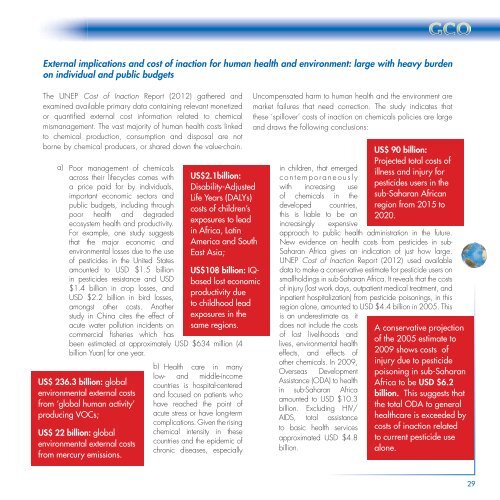Global Chemicals Outlook - UNEP
Global Chemicals Outlook - UNEP
Global Chemicals Outlook - UNEP
Create successful ePaper yourself
Turn your PDF publications into a flip-book with our unique Google optimized e-Paper software.
External implications and cost of inaction for human health and environment: large with heavy burden<br />
on individual and public budgets<br />
The <strong>UNEP</strong> Cost of Inaction Report (2012) gathered and<br />
examined available primary data containing relevant monetized<br />
or quantifi ed external cost information related to chemical<br />
mismanagement. The vast majority of human health costs linked<br />
to chemical production, consumption and disposal are not<br />
borne by chemical producers, or shared down the value-chain.<br />
a) Poor management of chemicals<br />
across their lifecycles comes with<br />
a price paid for by individuals,<br />
important economic sectors and<br />
public budgets, including through<br />
poor health and degraded<br />
ecosystem health and productivity.<br />
For example, one study suggests<br />
that the major economic and<br />
environmental losses due to the use<br />
of pesticides in the United States<br />
amounted to USD $1.5 billion<br />
in pesticides resistance and USD<br />
$1.4 billion in crop losses, and<br />
USD $2.2 billion in bird losses,<br />
amongst other costs. Another<br />
study in China cites the effect of<br />
acute water pollution incidents on<br />
commercial fi sheries which has<br />
US$ 236.3 billion: global<br />
environmental external costs<br />
from ‘global human activity’<br />
producing VOCs;<br />
US$ 22 billion: global<br />
environmental external costs<br />
from mercury emissions.<br />
US$2.1billion:<br />
Disability-Adjusted<br />
Life Years (DALYs)<br />
costs of children’s<br />
exposures to lead<br />
in Africa, Latin<br />
America and South<br />
East Asia;<br />
US$108 billion: IQbased<br />
lost economic<br />
productivity due<br />
to childhood lead<br />
exposures in the<br />
same regions.<br />
been estimated at approximately USD $634 million (4<br />
billion Yuan) for one year.<br />
b) Health care in many<br />
low- and middle-income<br />
countries is hospital-centered<br />
and focused on patients who<br />
have reached the point of<br />
acute stress or have long-term<br />
complications. Given the rising<br />
chemical intensity in these<br />
countries and the epidemic of<br />
chronic diseases, especially<br />
Uncompensated harm to human health and the environment are<br />
market failures that need correction. The study indicates that<br />
these ‘spillover’ costs of inaction on chemicals policies are large<br />
and draws the following conclusions:<br />
in children, that emerged<br />
contemporaneously<br />
with increasing use<br />
of chemicals in the<br />
developed countries,<br />
this is liable to be an<br />
increasingly expensive<br />
US$ 90 billion:<br />
Projected total costs of<br />
illness and injury for<br />
pesticides users in the<br />
sub-Saharan African<br />
region from 2015 to<br />
2020.<br />
approach to public health administration in the future.<br />
New evidence on health costs from pesticides in sub-<br />
Saharan Africa gives an indication of just how large.<br />
<strong>UNEP</strong> Cost of Inaction Report (2012) used available<br />
data to make a conservative estimate for pesticide users on<br />
smallholdings in sub-Saharan Africa. It reveals that the costs<br />
of injury (lost work days, outpatient medical treatment, and<br />
inpatient hospitalization) from pesticide poisonings, in this<br />
region alone, amounted to USD $4.4 billion in 2005. This<br />
is an underestimate as it<br />
does not include the costs<br />
of lost livelihoods and<br />
lives, environmental health<br />
effects, and effects of<br />
other chemicals. In 2009,<br />
Overseas Development<br />
Assistance (ODA) to health<br />
in sub-Saharan Africa<br />
amounted to USD $10.3<br />
billion. Excluding HIV/<br />
AIDS, total assistance<br />
to basic health services<br />
approximated USD $4.8<br />
billion.<br />
A conservative projection<br />
of the 2005 estimate to<br />
2009 shows costs of<br />
injury due to pesticide<br />
poisoning in sub-Saharan<br />
Africa to be USD $6.2<br />
billion. This suggests that<br />
the total ODA to general<br />
healthcare is exceeded by<br />
costs of inaction related<br />
to current pesticide use<br />
alone.<br />
29

















